LAW105: Negligence and Accountant's Professional Life Essay
VerifiedAdded on 2022/09/21
|8
|2027
|30
Essay
AI Summary
This essay examines the tort of negligence, a common legal wrong arising from a failure to exercise reasonable care, as defined under common law. It explores the four key elements required to establish negligence: duty of care, breach of that duty, causation of harm, and actual harm suffered by the plaintiff. The essay delves into the concept of duty of care, distinguishing between general and special duties, and traces the evolution of legal tests used to determine its presence, including the neighbor test and the Caparo test. It further analyzes the concepts of breach of duty, causation, and harm, with reference to relevant case law. The essay then discusses the implications of negligence for accountants, specifically focusing on professional negligence and its impact on financial loss. It highlights the duty of care accountants owe to their clients, the standards expected, and the consequences of failing to meet these standards, providing examples and relevant case law such as Boyd v Ackley [1962]. The essay concludes by emphasizing the importance of adhering to professional and ethical standards to avoid claims of professional negligence. The essay makes references to relevant legislation, articles and law reports.
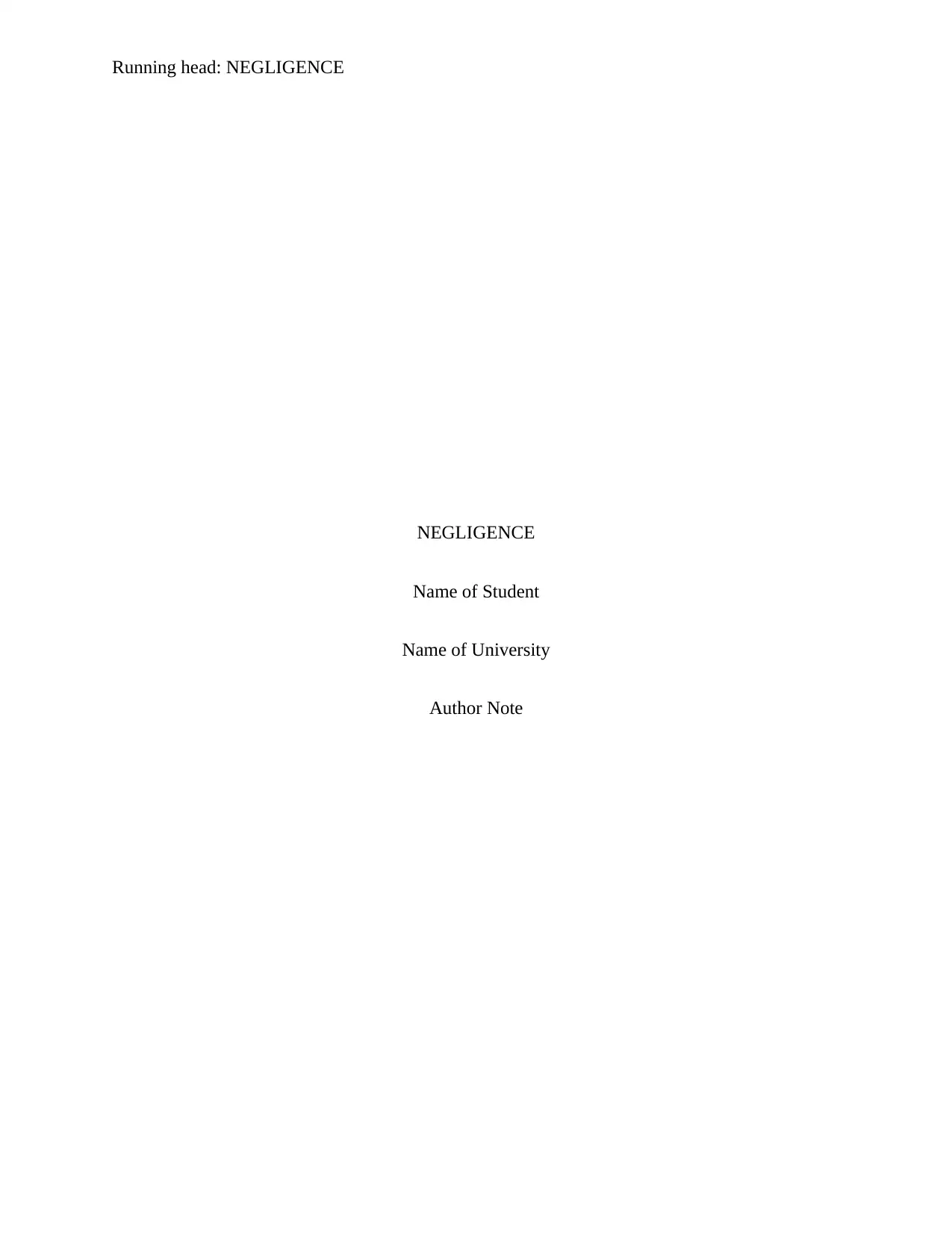
Running head: NEGLIGENCE
NEGLIGENCE
Name of Student
Name of University
Author Note
NEGLIGENCE
Name of Student
Name of University
Author Note
Paraphrase This Document
Need a fresh take? Get an instant paraphrase of this document with our AI Paraphraser
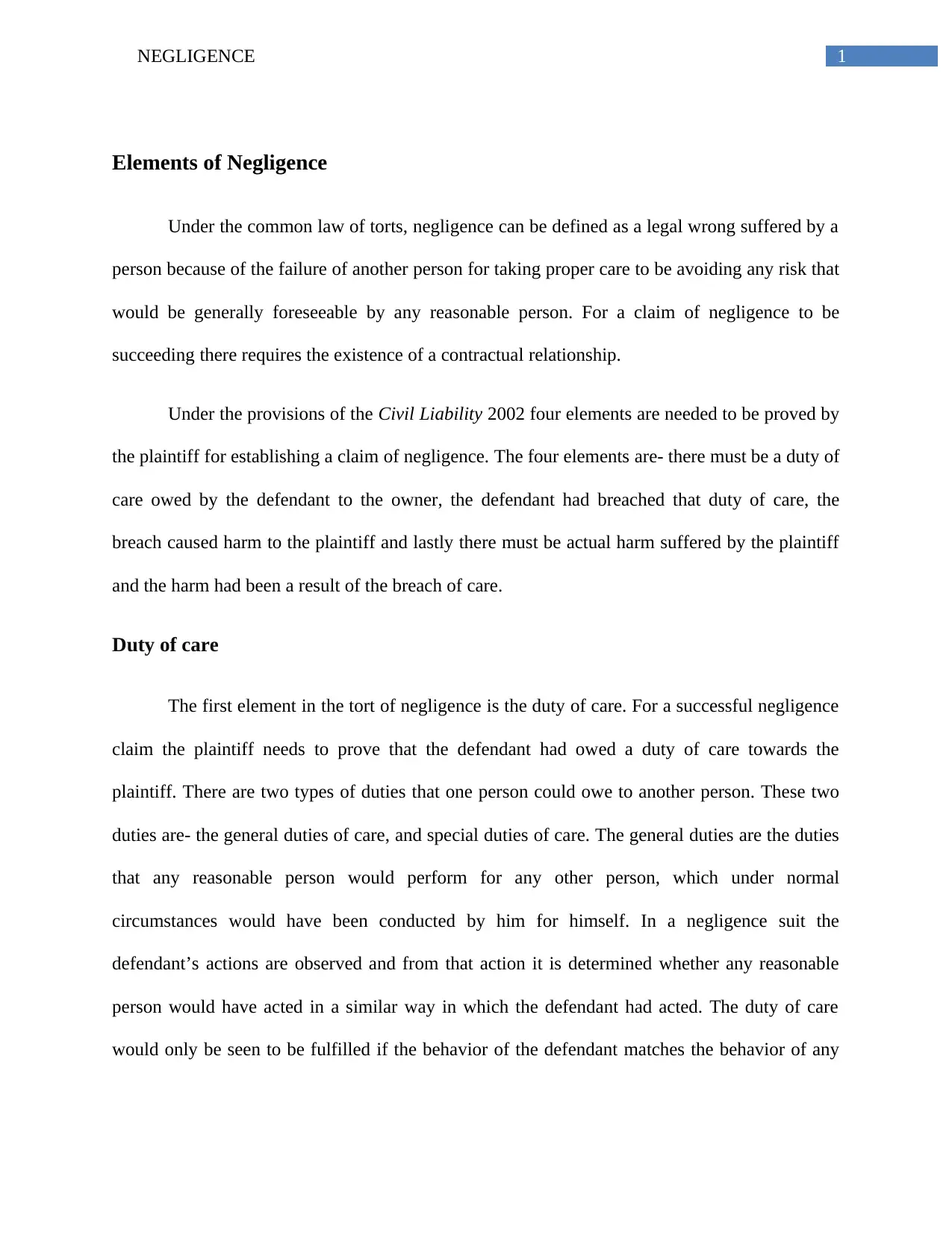
1NEGLIGENCE
Elements of Negligence
Under the common law of torts, negligence can be defined as a legal wrong suffered by a
person because of the failure of another person for taking proper care to be avoiding any risk that
would be generally foreseeable by any reasonable person. For a claim of negligence to be
succeeding there requires the existence of a contractual relationship.
Under the provisions of the Civil Liability 2002 four elements are needed to be proved by
the plaintiff for establishing a claim of negligence. The four elements are- there must be a duty of
care owed by the defendant to the owner, the defendant had breached that duty of care, the
breach caused harm to the plaintiff and lastly there must be actual harm suffered by the plaintiff
and the harm had been a result of the breach of care.
Duty of care
The first element in the tort of negligence is the duty of care. For a successful negligence
claim the plaintiff needs to prove that the defendant had owed a duty of care towards the
plaintiff. There are two types of duties that one person could owe to another person. These two
duties are- the general duties of care, and special duties of care. The general duties are the duties
that any reasonable person would perform for any other person, which under normal
circumstances would have been conducted by him for himself. In a negligence suit the
defendant’s actions are observed and from that action it is determined whether any reasonable
person would have acted in a similar way in which the defendant had acted. The duty of care
would only be seen to be fulfilled if the behavior of the defendant matches the behavior of any
Elements of Negligence
Under the common law of torts, negligence can be defined as a legal wrong suffered by a
person because of the failure of another person for taking proper care to be avoiding any risk that
would be generally foreseeable by any reasonable person. For a claim of negligence to be
succeeding there requires the existence of a contractual relationship.
Under the provisions of the Civil Liability 2002 four elements are needed to be proved by
the plaintiff for establishing a claim of negligence. The four elements are- there must be a duty of
care owed by the defendant to the owner, the defendant had breached that duty of care, the
breach caused harm to the plaintiff and lastly there must be actual harm suffered by the plaintiff
and the harm had been a result of the breach of care.
Duty of care
The first element in the tort of negligence is the duty of care. For a successful negligence
claim the plaintiff needs to prove that the defendant had owed a duty of care towards the
plaintiff. There are two types of duties that one person could owe to another person. These two
duties are- the general duties of care, and special duties of care. The general duties are the duties
that any reasonable person would perform for any other person, which under normal
circumstances would have been conducted by him for himself. In a negligence suit the
defendant’s actions are observed and from that action it is determined whether any reasonable
person would have acted in a similar way in which the defendant had acted. The duty of care
would only be seen to be fulfilled if the behavior of the defendant matches the behavior of any
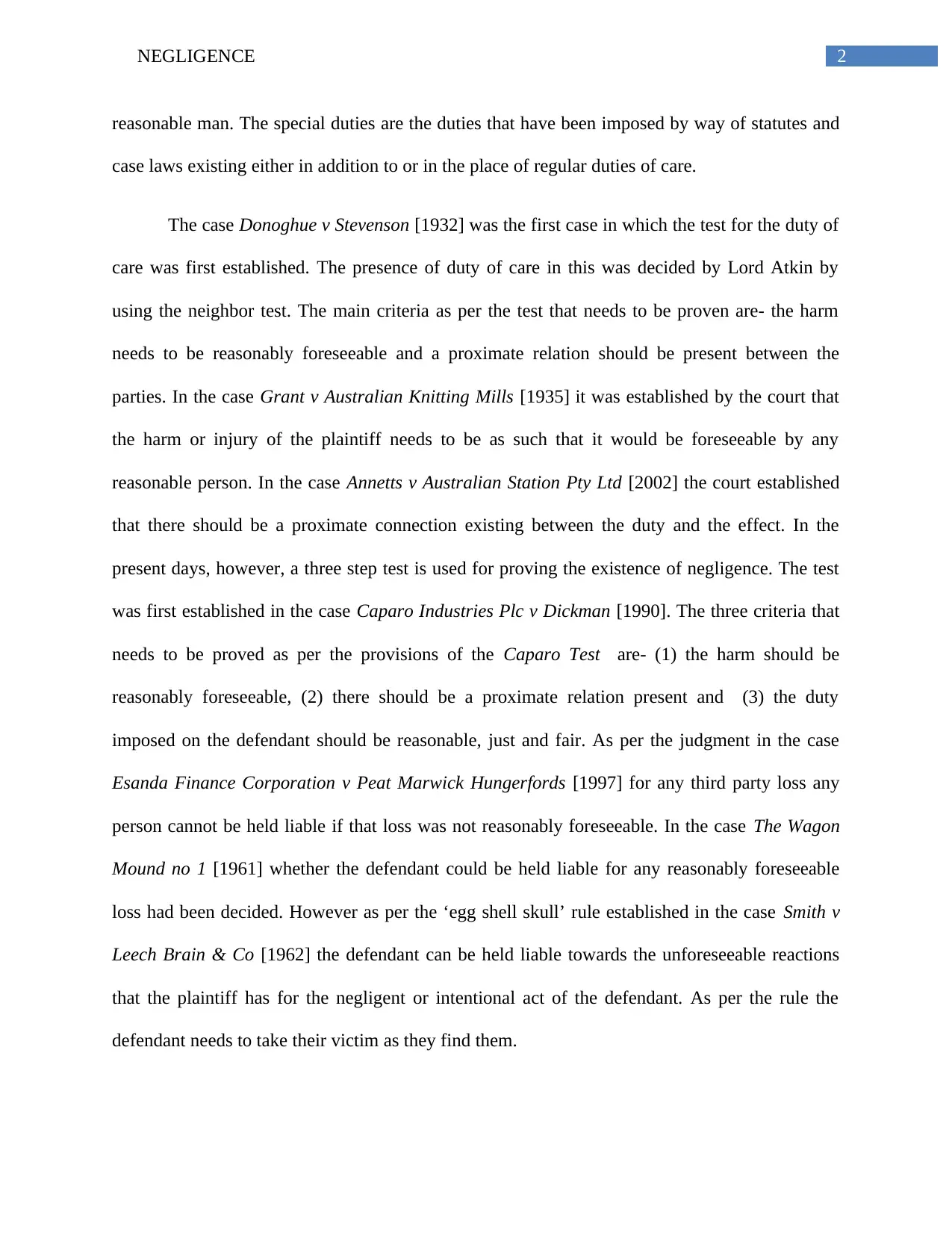
2NEGLIGENCE
reasonable man. The special duties are the duties that have been imposed by way of statutes and
case laws existing either in addition to or in the place of regular duties of care.
The case Donoghue v Stevenson [1932] was the first case in which the test for the duty of
care was first established. The presence of duty of care in this was decided by Lord Atkin by
using the neighbor test. The main criteria as per the test that needs to be proven are- the harm
needs to be reasonably foreseeable and a proximate relation should be present between the
parties. In the case Grant v Australian Knitting Mills [1935] it was established by the court that
the harm or injury of the plaintiff needs to be as such that it would be foreseeable by any
reasonable person. In the case Annetts v Australian Station Pty Ltd [2002] the court established
that there should be a proximate connection existing between the duty and the effect. In the
present days, however, a three step test is used for proving the existence of negligence. The test
was first established in the case Caparo Industries Plc v Dickman [1990]. The three criteria that
needs to be proved as per the provisions of the Caparo Test are- (1) the harm should be
reasonably foreseeable, (2) there should be a proximate relation present and (3) the duty
imposed on the defendant should be reasonable, just and fair. As per the judgment in the case
Esanda Finance Corporation v Peat Marwick Hungerfords [1997] for any third party loss any
person cannot be held liable if that loss was not reasonably foreseeable. In the case The Wagon
Mound no 1 [1961] whether the defendant could be held liable for any reasonably foreseeable
loss had been decided. However as per the ‘egg shell skull’ rule established in the case Smith v
Leech Brain & Co [1962] the defendant can be held liable towards the unforeseeable reactions
that the plaintiff has for the negligent or intentional act of the defendant. As per the rule the
defendant needs to take their victim as they find them.
reasonable man. The special duties are the duties that have been imposed by way of statutes and
case laws existing either in addition to or in the place of regular duties of care.
The case Donoghue v Stevenson [1932] was the first case in which the test for the duty of
care was first established. The presence of duty of care in this was decided by Lord Atkin by
using the neighbor test. The main criteria as per the test that needs to be proven are- the harm
needs to be reasonably foreseeable and a proximate relation should be present between the
parties. In the case Grant v Australian Knitting Mills [1935] it was established by the court that
the harm or injury of the plaintiff needs to be as such that it would be foreseeable by any
reasonable person. In the case Annetts v Australian Station Pty Ltd [2002] the court established
that there should be a proximate connection existing between the duty and the effect. In the
present days, however, a three step test is used for proving the existence of negligence. The test
was first established in the case Caparo Industries Plc v Dickman [1990]. The three criteria that
needs to be proved as per the provisions of the Caparo Test are- (1) the harm should be
reasonably foreseeable, (2) there should be a proximate relation present and (3) the duty
imposed on the defendant should be reasonable, just and fair. As per the judgment in the case
Esanda Finance Corporation v Peat Marwick Hungerfords [1997] for any third party loss any
person cannot be held liable if that loss was not reasonably foreseeable. In the case The Wagon
Mound no 1 [1961] whether the defendant could be held liable for any reasonably foreseeable
loss had been decided. However as per the ‘egg shell skull’ rule established in the case Smith v
Leech Brain & Co [1962] the defendant can be held liable towards the unforeseeable reactions
that the plaintiff has for the negligent or intentional act of the defendant. As per the rule the
defendant needs to take their victim as they find them.
⊘ This is a preview!⊘
Do you want full access?
Subscribe today to unlock all pages.

Trusted by 1+ million students worldwide
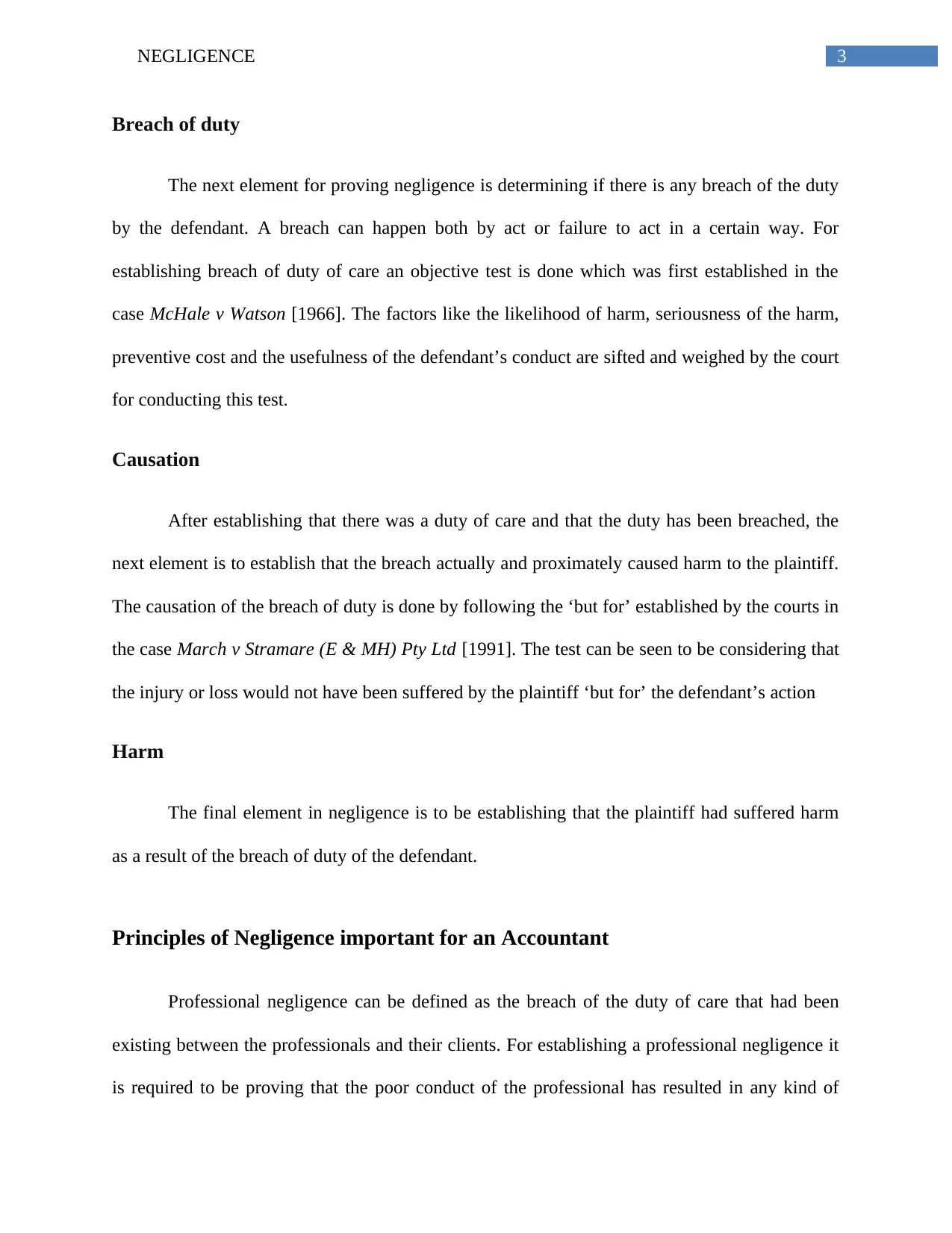
3NEGLIGENCE
Breach of duty
The next element for proving negligence is determining if there is any breach of the duty
by the defendant. A breach can happen both by act or failure to act in a certain way. For
establishing breach of duty of care an objective test is done which was first established in the
case McHale v Watson [1966]. The factors like the likelihood of harm, seriousness of the harm,
preventive cost and the usefulness of the defendant’s conduct are sifted and weighed by the court
for conducting this test.
Causation
After establishing that there was a duty of care and that the duty has been breached, the
next element is to establish that the breach actually and proximately caused harm to the plaintiff.
The causation of the breach of duty is done by following the ‘but for’ established by the courts in
the case March v Stramare (E & MH) Pty Ltd [1991]. The test can be seen to be considering that
the injury or loss would not have been suffered by the plaintiff ‘but for’ the defendant’s action
Harm
The final element in negligence is to be establishing that the plaintiff had suffered harm
as a result of the breach of duty of the defendant.
Principles of Negligence important for an Accountant
Professional negligence can be defined as the breach of the duty of care that had been
existing between the professionals and their clients. For establishing a professional negligence it
is required to be proving that the poor conduct of the professional has resulted in any kind of
Breach of duty
The next element for proving negligence is determining if there is any breach of the duty
by the defendant. A breach can happen both by act or failure to act in a certain way. For
establishing breach of duty of care an objective test is done which was first established in the
case McHale v Watson [1966]. The factors like the likelihood of harm, seriousness of the harm,
preventive cost and the usefulness of the defendant’s conduct are sifted and weighed by the court
for conducting this test.
Causation
After establishing that there was a duty of care and that the duty has been breached, the
next element is to establish that the breach actually and proximately caused harm to the plaintiff.
The causation of the breach of duty is done by following the ‘but for’ established by the courts in
the case March v Stramare (E & MH) Pty Ltd [1991]. The test can be seen to be considering that
the injury or loss would not have been suffered by the plaintiff ‘but for’ the defendant’s action
Harm
The final element in negligence is to be establishing that the plaintiff had suffered harm
as a result of the breach of duty of the defendant.
Principles of Negligence important for an Accountant
Professional negligence can be defined as the breach of the duty of care that had been
existing between the professionals and their clients. For establishing a professional negligence it
is required to be proving that the poor conduct of the professional has resulted in any kind of
Paraphrase This Document
Need a fresh take? Get an instant paraphrase of this document with our AI Paraphraser
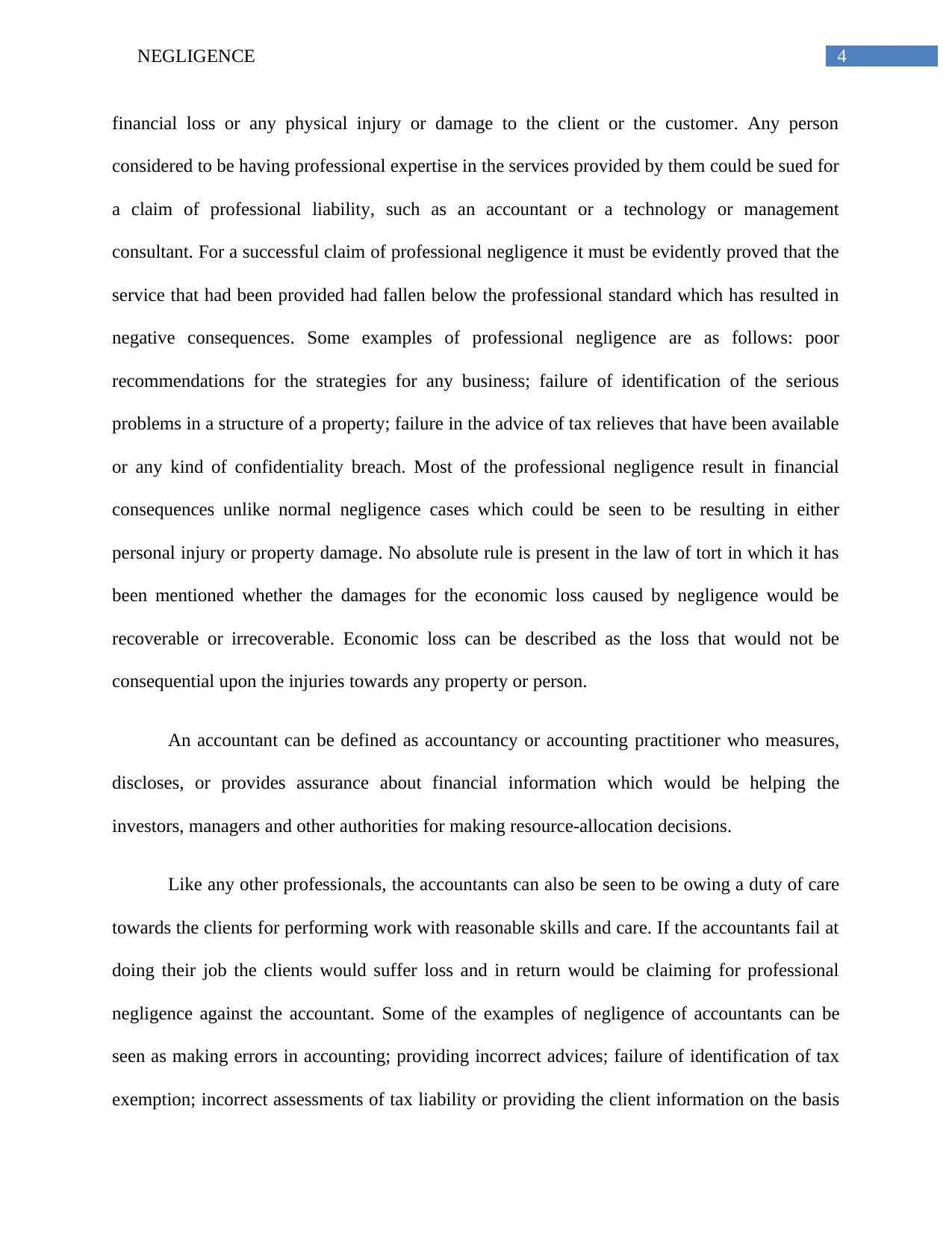
4NEGLIGENCE
financial loss or any physical injury or damage to the client or the customer. Any person
considered to be having professional expertise in the services provided by them could be sued for
a claim of professional liability, such as an accountant or a technology or management
consultant. For a successful claim of professional negligence it must be evidently proved that the
service that had been provided had fallen below the professional standard which has resulted in
negative consequences. Some examples of professional negligence are as follows: poor
recommendations for the strategies for any business; failure of identification of the serious
problems in a structure of a property; failure in the advice of tax relieves that have been available
or any kind of confidentiality breach. Most of the professional negligence result in financial
consequences unlike normal negligence cases which could be seen to be resulting in either
personal injury or property damage. No absolute rule is present in the law of tort in which it has
been mentioned whether the damages for the economic loss caused by negligence would be
recoverable or irrecoverable. Economic loss can be described as the loss that would not be
consequential upon the injuries towards any property or person.
An accountant can be defined as accountancy or accounting practitioner who measures,
discloses, or provides assurance about financial information which would be helping the
investors, managers and other authorities for making resource-allocation decisions.
Like any other professionals, the accountants can also be seen to be owing a duty of care
towards the clients for performing work with reasonable skills and care. If the accountants fail at
doing their job the clients would suffer loss and in return would be claiming for professional
negligence against the accountant. Some of the examples of negligence of accountants can be
seen as making errors in accounting; providing incorrect advices; failure of identification of tax
exemption; incorrect assessments of tax liability or providing the client information on the basis
financial loss or any physical injury or damage to the client or the customer. Any person
considered to be having professional expertise in the services provided by them could be sued for
a claim of professional liability, such as an accountant or a technology or management
consultant. For a successful claim of professional negligence it must be evidently proved that the
service that had been provided had fallen below the professional standard which has resulted in
negative consequences. Some examples of professional negligence are as follows: poor
recommendations for the strategies for any business; failure of identification of the serious
problems in a structure of a property; failure in the advice of tax relieves that have been available
or any kind of confidentiality breach. Most of the professional negligence result in financial
consequences unlike normal negligence cases which could be seen to be resulting in either
personal injury or property damage. No absolute rule is present in the law of tort in which it has
been mentioned whether the damages for the economic loss caused by negligence would be
recoverable or irrecoverable. Economic loss can be described as the loss that would not be
consequential upon the injuries towards any property or person.
An accountant can be defined as accountancy or accounting practitioner who measures,
discloses, or provides assurance about financial information which would be helping the
investors, managers and other authorities for making resource-allocation decisions.
Like any other professionals, the accountants can also be seen to be owing a duty of care
towards the clients for performing work with reasonable skills and care. If the accountants fail at
doing their job the clients would suffer loss and in return would be claiming for professional
negligence against the accountant. Some of the examples of negligence of accountants can be
seen as making errors in accounting; providing incorrect advices; failure of identification of tax
exemption; incorrect assessments of tax liability or providing the client information on the basis
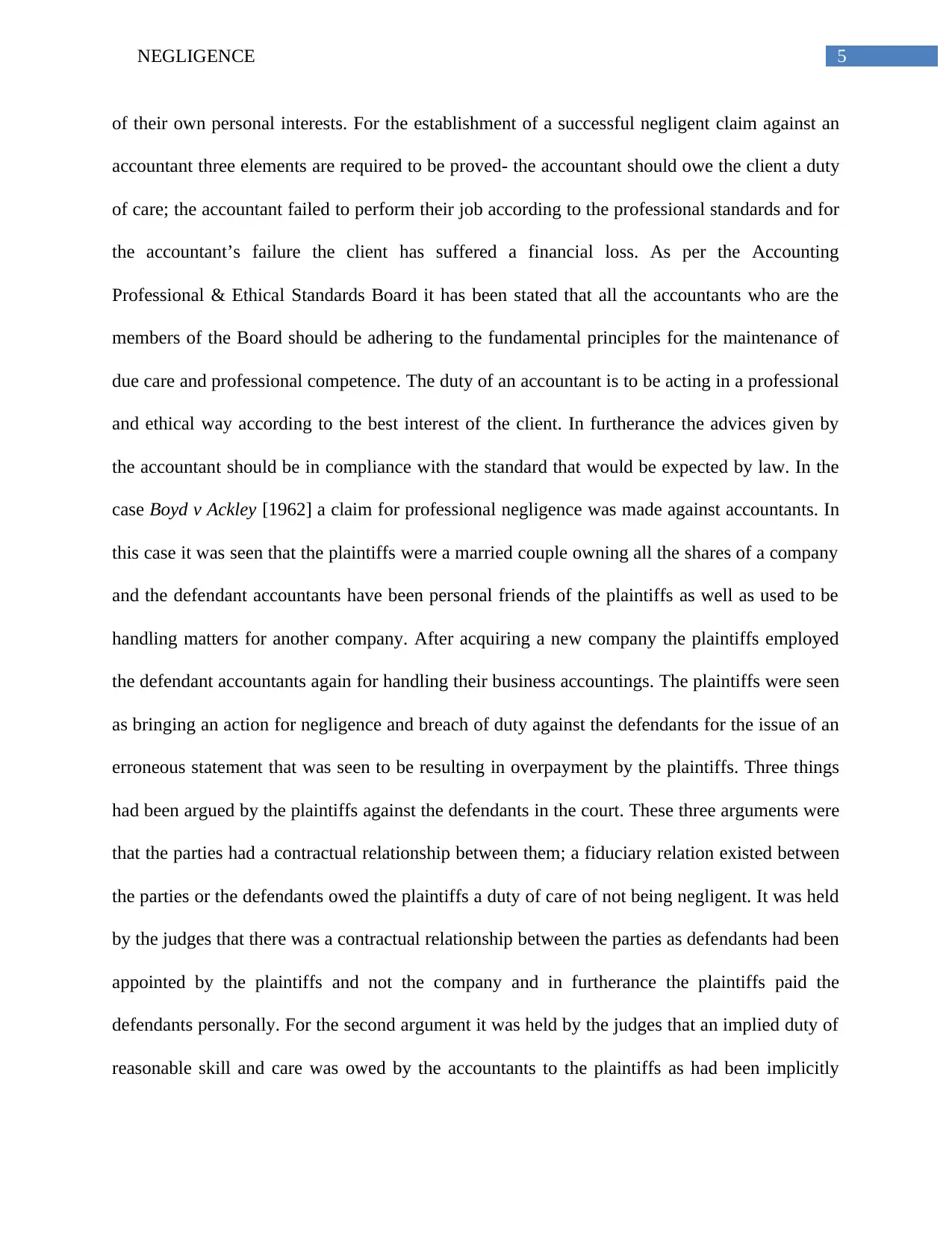
5NEGLIGENCE
of their own personal interests. For the establishment of a successful negligent claim against an
accountant three elements are required to be proved- the accountant should owe the client a duty
of care; the accountant failed to perform their job according to the professional standards and for
the accountant’s failure the client has suffered a financial loss. As per the Accounting
Professional & Ethical Standards Board it has been stated that all the accountants who are the
members of the Board should be adhering to the fundamental principles for the maintenance of
due care and professional competence. The duty of an accountant is to be acting in a professional
and ethical way according to the best interest of the client. In furtherance the advices given by
the accountant should be in compliance with the standard that would be expected by law. In the
case Boyd v Ackley [1962] a claim for professional negligence was made against accountants. In
this case it was seen that the plaintiffs were a married couple owning all the shares of a company
and the defendant accountants have been personal friends of the plaintiffs as well as used to be
handling matters for another company. After acquiring a new company the plaintiffs employed
the defendant accountants again for handling their business accountings. The plaintiffs were seen
as bringing an action for negligence and breach of duty against the defendants for the issue of an
erroneous statement that was seen to be resulting in overpayment by the plaintiffs. Three things
had been argued by the plaintiffs against the defendants in the court. These three arguments were
that the parties had a contractual relationship between them; a fiduciary relation existed between
the parties or the defendants owed the plaintiffs a duty of care of not being negligent. It was held
by the judges that there was a contractual relationship between the parties as defendants had been
appointed by the plaintiffs and not the company and in furtherance the plaintiffs paid the
defendants personally. For the second argument it was held by the judges that an implied duty of
reasonable skill and care was owed by the accountants to the plaintiffs as had been implicitly
of their own personal interests. For the establishment of a successful negligent claim against an
accountant three elements are required to be proved- the accountant should owe the client a duty
of care; the accountant failed to perform their job according to the professional standards and for
the accountant’s failure the client has suffered a financial loss. As per the Accounting
Professional & Ethical Standards Board it has been stated that all the accountants who are the
members of the Board should be adhering to the fundamental principles for the maintenance of
due care and professional competence. The duty of an accountant is to be acting in a professional
and ethical way according to the best interest of the client. In furtherance the advices given by
the accountant should be in compliance with the standard that would be expected by law. In the
case Boyd v Ackley [1962] a claim for professional negligence was made against accountants. In
this case it was seen that the plaintiffs were a married couple owning all the shares of a company
and the defendant accountants have been personal friends of the plaintiffs as well as used to be
handling matters for another company. After acquiring a new company the plaintiffs employed
the defendant accountants again for handling their business accountings. The plaintiffs were seen
as bringing an action for negligence and breach of duty against the defendants for the issue of an
erroneous statement that was seen to be resulting in overpayment by the plaintiffs. Three things
had been argued by the plaintiffs against the defendants in the court. These three arguments were
that the parties had a contractual relationship between them; a fiduciary relation existed between
the parties or the defendants owed the plaintiffs a duty of care of not being negligent. It was held
by the judges that there was a contractual relationship between the parties as defendants had been
appointed by the plaintiffs and not the company and in furtherance the plaintiffs paid the
defendants personally. For the second argument it was held by the judges that an implied duty of
reasonable skill and care was owed by the accountants to the plaintiffs as had been implicitly
⊘ This is a preview!⊘
Do you want full access?
Subscribe today to unlock all pages.

Trusted by 1+ million students worldwide
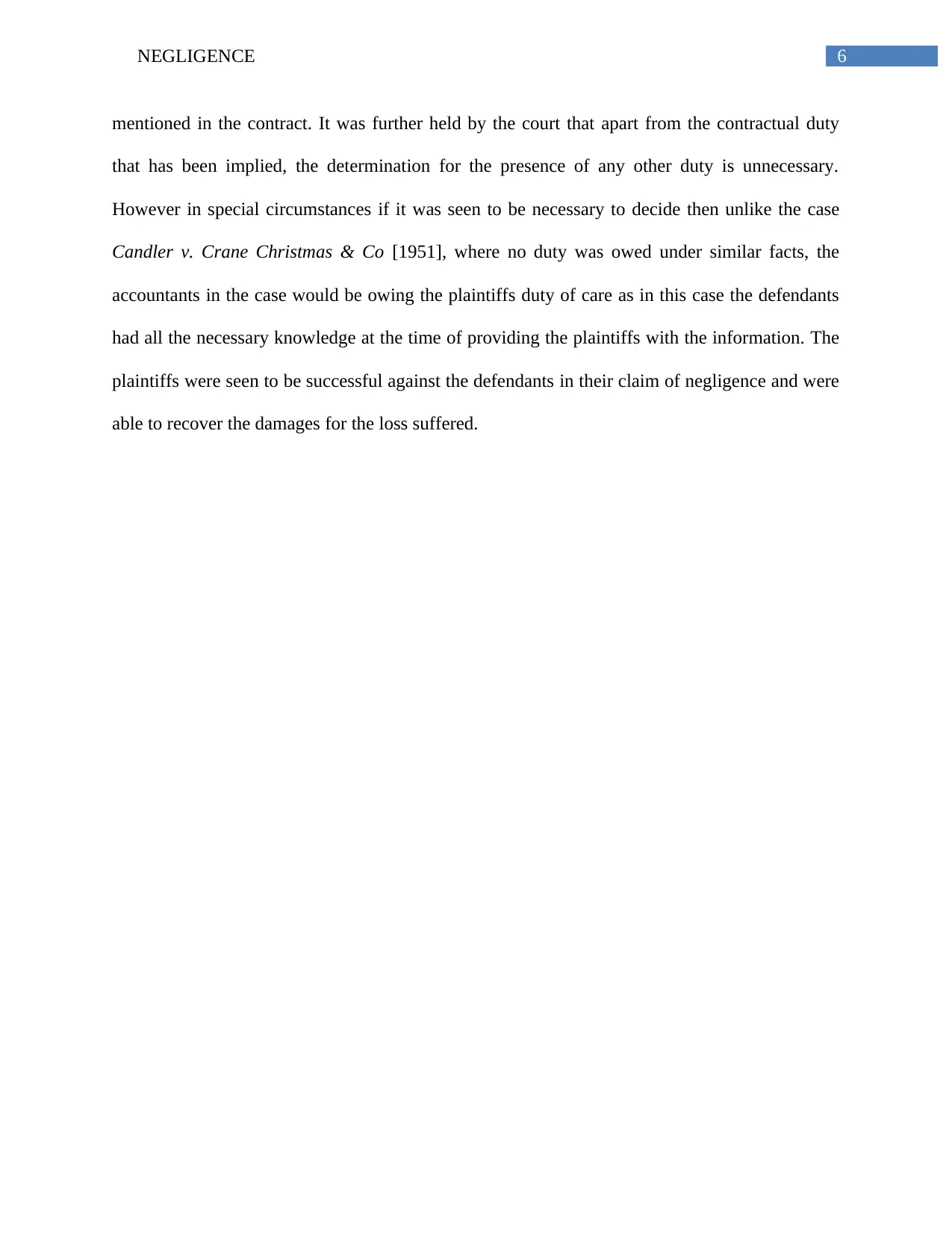
6NEGLIGENCE
mentioned in the contract. It was further held by the court that apart from the contractual duty
that has been implied, the determination for the presence of any other duty is unnecessary.
However in special circumstances if it was seen to be necessary to decide then unlike the case
Candler v. Crane Christmas & Co [1951], where no duty was owed under similar facts, the
accountants in the case would be owing the plaintiffs duty of care as in this case the defendants
had all the necessary knowledge at the time of providing the plaintiffs with the information. The
plaintiffs were seen to be successful against the defendants in their claim of negligence and were
able to recover the damages for the loss suffered.
mentioned in the contract. It was further held by the court that apart from the contractual duty
that has been implied, the determination for the presence of any other duty is unnecessary.
However in special circumstances if it was seen to be necessary to decide then unlike the case
Candler v. Crane Christmas & Co [1951], where no duty was owed under similar facts, the
accountants in the case would be owing the plaintiffs duty of care as in this case the defendants
had all the necessary knowledge at the time of providing the plaintiffs with the information. The
plaintiffs were seen to be successful against the defendants in their claim of negligence and were
able to recover the damages for the loss suffered.
Paraphrase This Document
Need a fresh take? Get an instant paraphrase of this document with our AI Paraphraser
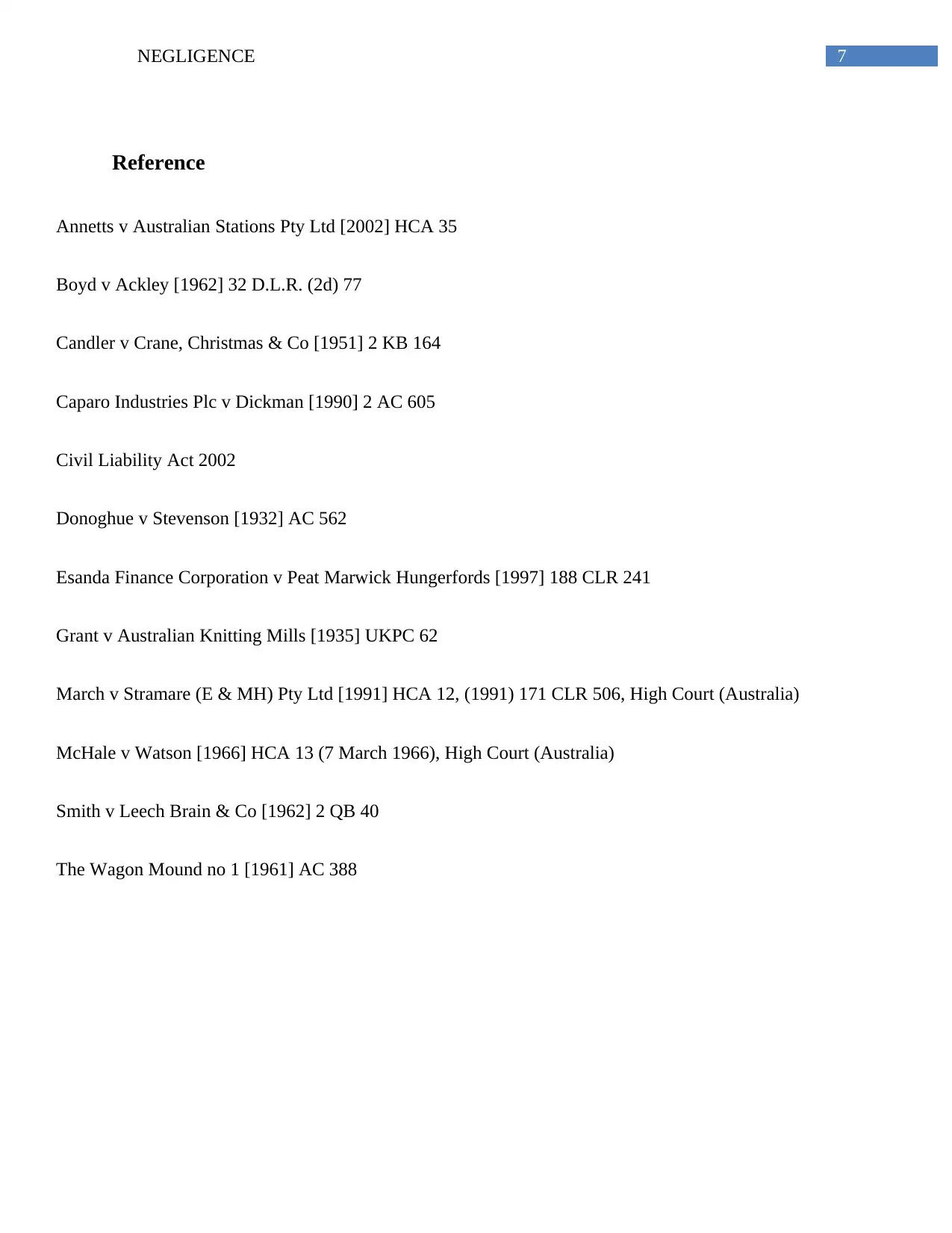
7NEGLIGENCE
Reference
Annetts v Australian Stations Pty Ltd [2002] HCA 35
Boyd v Ackley [1962] 32 D.L.R. (2d) 77
Candler v Crane, Christmas & Co [1951] 2 KB 164
Caparo Industries Plc v Dickman [1990] 2 AC 605
Civil Liability Act 2002
Donoghue v Stevenson [1932] AC 562
Esanda Finance Corporation v Peat Marwick Hungerfords [1997] 188 CLR 241
Grant v Australian Knitting Mills [1935] UKPC 62
March v Stramare (E & MH) Pty Ltd [1991] HCA 12, (1991) 171 CLR 506, High Court (Australia)
McHale v Watson [1966] HCA 13 (7 March 1966), High Court (Australia)
Smith v Leech Brain & Co [1962] 2 QB 40
The Wagon Mound no 1 [1961] AC 388
Reference
Annetts v Australian Stations Pty Ltd [2002] HCA 35
Boyd v Ackley [1962] 32 D.L.R. (2d) 77
Candler v Crane, Christmas & Co [1951] 2 KB 164
Caparo Industries Plc v Dickman [1990] 2 AC 605
Civil Liability Act 2002
Donoghue v Stevenson [1932] AC 562
Esanda Finance Corporation v Peat Marwick Hungerfords [1997] 188 CLR 241
Grant v Australian Knitting Mills [1935] UKPC 62
March v Stramare (E & MH) Pty Ltd [1991] HCA 12, (1991) 171 CLR 506, High Court (Australia)
McHale v Watson [1966] HCA 13 (7 March 1966), High Court (Australia)
Smith v Leech Brain & Co [1962] 2 QB 40
The Wagon Mound no 1 [1961] AC 388
1 out of 8
Related Documents
Your All-in-One AI-Powered Toolkit for Academic Success.
+13062052269
info@desklib.com
Available 24*7 on WhatsApp / Email
![[object Object]](/_next/static/media/star-bottom.7253800d.svg)
Unlock your academic potential
Copyright © 2020–2025 A2Z Services. All Rights Reserved. Developed and managed by ZUCOL.





